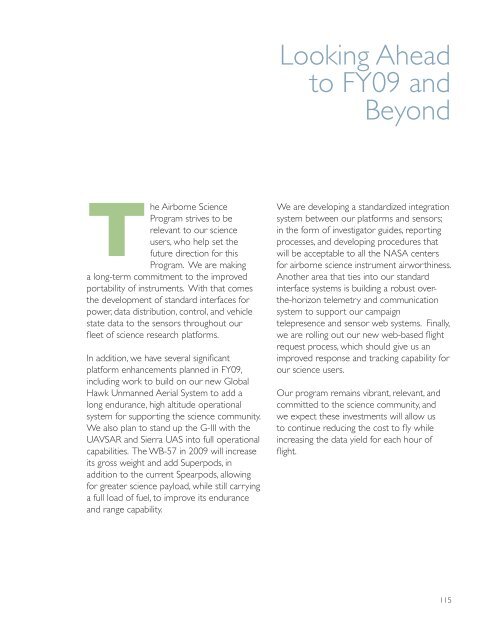2008 Annual Report - NASA Airborne Science Program
2008 Annual Report - NASA Airborne Science Program
2008 Annual Report - NASA Airborne Science Program
You also want an ePaper? Increase the reach of your titles
YUMPU automatically turns print PDFs into web optimized ePapers that Google loves.
Looking Ahead<br />
to FY09 and<br />
Beyond<br />
The <strong>Airborne</strong> <strong>Science</strong><br />
<strong>Program</strong> strives to be<br />
relevant to our science<br />
users, who help set the<br />
future direction for this<br />
<strong>Program</strong>. We are making<br />
a long-term commitment to the improved<br />
portability of instruments. With that comes<br />
the development of standard interfaces for<br />
power, data distribution, control, and vehicle<br />
state data to the sensors throughout our<br />
fleet of science research platforms.<br />
In addition, we have several significant<br />
platform enhancements planned in FY09,<br />
including work to build on our new Global<br />
Hawk Unmanned Aerial System to add a<br />
long endurance, high altitude operational<br />
system for supporting the science community.<br />
We also plan to stand up the G-III with the<br />
UAVSAR and Sierra UAS into full operational<br />
capabilities. The WB-57 in 2009 will increase<br />
its gross weight and add Superpods, in<br />
addition to the current Spearpods, allowing<br />
for greater science payload, while still carrying<br />
a full load of fuel, to improve its endurance<br />
and range capability.<br />
We are developing a standardized integration<br />
system between our platforms and sensors;<br />
in the form of investigator guides, reporting<br />
processes, and developing procedures that<br />
will be acceptable to all the <strong>NASA</strong> centers<br />
for airborne science instrument airworthiness.<br />
Another area that ties into our standard<br />
interface systems is building a robust overthe-horizon<br />
telemetry and communication<br />
system to support our campaign<br />
telepresence and sensor web systems. Finally,<br />
we are rolling out our new web-based flight<br />
request process, which should give us an<br />
improved response and tracking capability for<br />
our science users.<br />
Our program remains vibrant, relevant, and<br />
committed to the science community, and<br />
we expect these investments will allow us<br />
to continue reducing the cost to fly while<br />
increasing the data yield for each hour of<br />
flight.<br />
115











